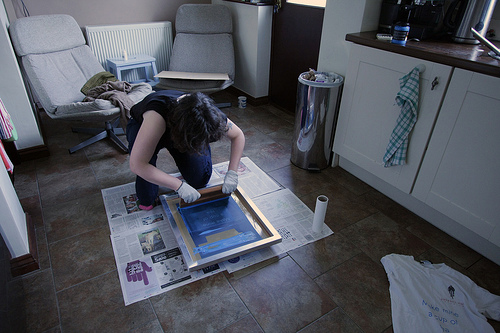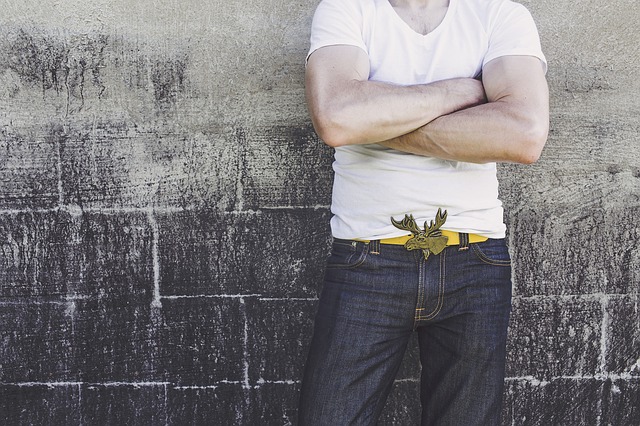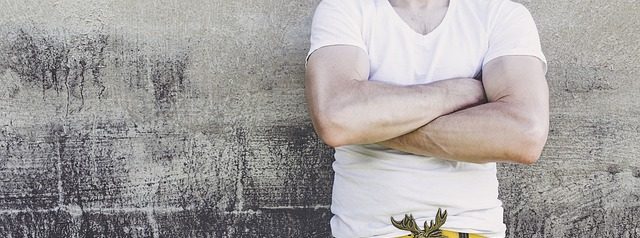How to Save by Printing Your Own T-shirts
Where Did All These Cheap T-shirts Originate?
T-shirts surfaced around the dawn of the 20th century in the dress of the American naval force as white knitted undershirts worn beneath a uniform, until they emerged as an external covering in less formal settings. Undershirts were associated with the working class, and in American films of the 1950s they were the garment favoured by actors like James Dean and Marlon Brando, cast as youthful rebels.
The first known printed T-shirt was produced in 1948 as a campaign item advertising a candidate for political office, and consumer demand for them surged forward in the 1970s when T-shirts printed with the logos of rock bands began to be sold at concerts. When the punk rock movement adopted the ripped and pinned T-shirt as a fashion statement, T-shirts found a new home in the UK.


Printing the first shirt by Phil Gradwell, on Flickr. This work is licensed under a Creative Commons Attribution 4.0 International License.
Learn to Screen-print Your Own T-shirts
Screen-printing your own shirts at home sounds terribly complicated, but isn’t. It’s simple, supplies are cheap, you can print anything you fancy, and if you enjoy working with your hands it’s pure entertainment. You can consult a web guide to screen-printing – there are many available – but to give you an idea of the necessary steps, here’s a brief summary.
Equipment
The silk screen is a wooden frame to which a silk-like polyester fabric (110 mesh) has been attached, and you can either buy one or make your own. You’ll cover your hands with gloves, distribute emulsion and ink with a squeegee, and stuff a bit of cardboard into your shirt beneath the image to catch excess ink.
Supplies
Other than the T-shirt itself, you’ll need a bottle of photo emulsion and one of sensitiser (also called activator) to mix together. There’s a special fabric ink formulated for the silk screen method.
Work space
You’ll work on a table in a darkroom and develop your image using a light bulb that delivers the equivalent of between 150 and 200 watts.

RyanMcGuire / Pixabay
Steps to Printing Your T-shirt
Select your image (no intricate linework for your first go) and create a stencil. You can use a transparency onto which you’ve printed a black image that will block light, or you can print the image onto ordinary paper and cut it out.
Combine the photo emulsion and sensitiser, then coat your screen with the resulting liquid. If you place a bin bag on your work table under the screen, you’ll avoid mess. Spread evenly and quickly, using the squeegee.
After the screen dries, place your opaque image in the center and expose it under the light. If you underexpose it, the emulsion won’t adhere to create an outline of your image, and if you overexpose, some of the emulsion will stick to your image.
Place the image on the screen backwards (the opposite of the way you want it to appear) before exposing. You may want to weight it with a pane of glass. When exposure is complete, wash the emulsion away from the image.
Next print the shirt itself by stretching it out on the work table and placing the screen over it. Squeeze out some fabric ink and drag it over the image, again using the squeegee. The more pressure you apply, the more ink passes through the screen and the darker your image will look on the shirt.
Hang the printed shirt up to dry, then cure the ink by using a hot iron or popping the shirt into an oven very briefly. Your shirt is complete!
Buy Your T-shirts Cheap from the People Who Screen-printed Them
If you’ve just tried the walkthrough above, you’ll think screen printers are remarkably underpaid when you see some of the prices you can find online. Many of the small commercial ventures invest in a press to help them gallop through the work, which is an easy way to turn out multi-colour print jobs. In order to buy the necessary equipment you may consider help from a payday loan, this will allow you to get your project started without affecting your weekly budget.
You’ll probably find the best deals when you purchase in bulk, which is well suited for kitting out a group of people (team, class in school, youth club, church group) in casual uniform. If you don’t want to buy 100 copies of the same shirt just to get the five-quid rate, you can pay £10 at a site that lets you choose your own image, text and shirt body.
If you’ve generated salable designs of your own, there are online printers that invite merchandising partners – the printer supplies inventory, fills orders, and shares the profits with you.

